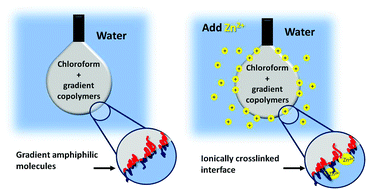Formation and mechanical characterization of ionically crosslinked membranes at oil–water interfaces
Abstract
Here we report on the preparation and mechanical characterization of a 2-D self-assembled membrane formed by ionically crosslinking the polyelectrolyte parts of a gradient amphiphilic copolymer at oil and water interfaces. To fabricate these membranes, chloroform solutions of styrene–acrylic acid copolymers were suspended as pendant drops in an aqueous embedding phase. Due to the amphiphilic nature of these molecules, the copolymer chains migrate to the oil–water interface creating an interfacial layer. Upon the addition of zinc acetate to the embedding phase, crosslinks between copolymer molecules are formed via zinc–carboxylate complexes. While ionically crosslinked block copolymer membranes were critically damaged after one expansion cycle, ionically crosslinked gradient copolymers formed durable membranes that maintained their physical integrity through multiple expansion–compression–expansion cycles. This difference in mechanical behavior is attributed to the fact that gradient copolymers are more effective interfacial modifiers and have a significantly different molecular alignment at the oil–water interface. Additionally by changing the incubation time from 20 to 30 minutes, the low-strain dilatational modulus of these membranes was significantly increased due to higher interfacial coverage and crosslinking density. Longer incubation times also led to a distinct yield point and plastic deformation behavior at larger strains. Further mechanical characterization of the membranes showed that they can be quite robust and that by replacing the internal oil phase with an aqueous solution, future testing of membrane filtration and permeation may be possible.


 Please wait while we load your content...
Please wait while we load your content...